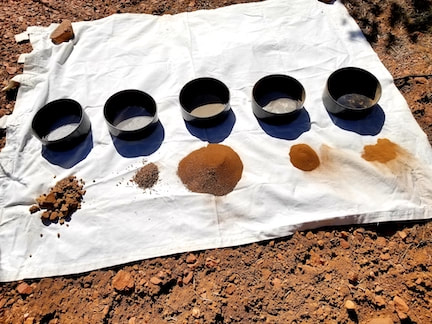Where do sediments originally come from?
If we go up in the mountains, to places where the bedrock is breaking down and disintegrating under the stress of changing weather and growing plants, we might get a clue.
These hillsides are underlain by solid granite. But if we look at the material on the forest floor, we discover a loose mix of rock fragments and organic matter. If we sort this into size fractions as we did earlier with the sediment in the Santa Fe River bed, we will get a surprise.
If we go up in the mountains, to places where the bedrock is breaking down and disintegrating under the stress of changing weather and growing plants, we might get a clue.
These hillsides are underlain by solid granite. But if we look at the material on the forest floor, we discover a loose mix of rock fragments and organic matter. If we sort this into size fractions as we did earlier with the sediment in the Santa Fe River bed, we will get a surprise.
This is a different distribution than that which we observed in the river bed. The bigger pieces are rough and unrounded. They are all made of the same rock, rather than a mix of different rocks. There is a wide range of sizes, with plenty of silt and clay-sized material. The sand-sized fractions are 'dirty' with clinging silt and clay.
Gravity and storm runoff are gradually moving all this loose material downslope.
So here we are witness to the beginning of the formation of sediment and sedimentary rock: the disintegration of pre-existing rock by a process called weathering.
Rocks are perishable. Most of the minerals that make up the rocks are chemically stable in the warm and isolated womb of the interior, but they begin to break down in the harsh, wet, oxygenated conditions in which we live, up here at the surface. The rocks themselves become brittle in the cold, and crack. Frost and plant roots wedge into them. Ground water, made slightly acidic by carbon dioxide in the soil, begins to pry the minerals apart. Oxygen bullies out the metallic elements to form new compounds.
These cascading mechanical and chemical processes ultimately disintegrate even the toughest bedrock. Downslope movement slowly removes the cover of soil and broken rock and exposes fresh rock to new cycles of mechanical and chemical weathering.
And once the disintegrated rock is mobilized by running water, blowing wind, or flowing ice, we call it sediment.
Gravity and storm runoff are gradually moving all this loose material downslope.
So here we are witness to the beginning of the formation of sediment and sedimentary rock: the disintegration of pre-existing rock by a process called weathering.
Rocks are perishable. Most of the minerals that make up the rocks are chemically stable in the warm and isolated womb of the interior, but they begin to break down in the harsh, wet, oxygenated conditions in which we live, up here at the surface. The rocks themselves become brittle in the cold, and crack. Frost and plant roots wedge into them. Ground water, made slightly acidic by carbon dioxide in the soil, begins to pry the minerals apart. Oxygen bullies out the metallic elements to form new compounds.
These cascading mechanical and chemical processes ultimately disintegrate even the toughest bedrock. Downslope movement slowly removes the cover of soil and broken rock and exposes fresh rock to new cycles of mechanical and chemical weathering.
And once the disintegrated rock is mobilized by running water, blowing wind, or flowing ice, we call it sediment.


 RSS Feed
RSS Feed
